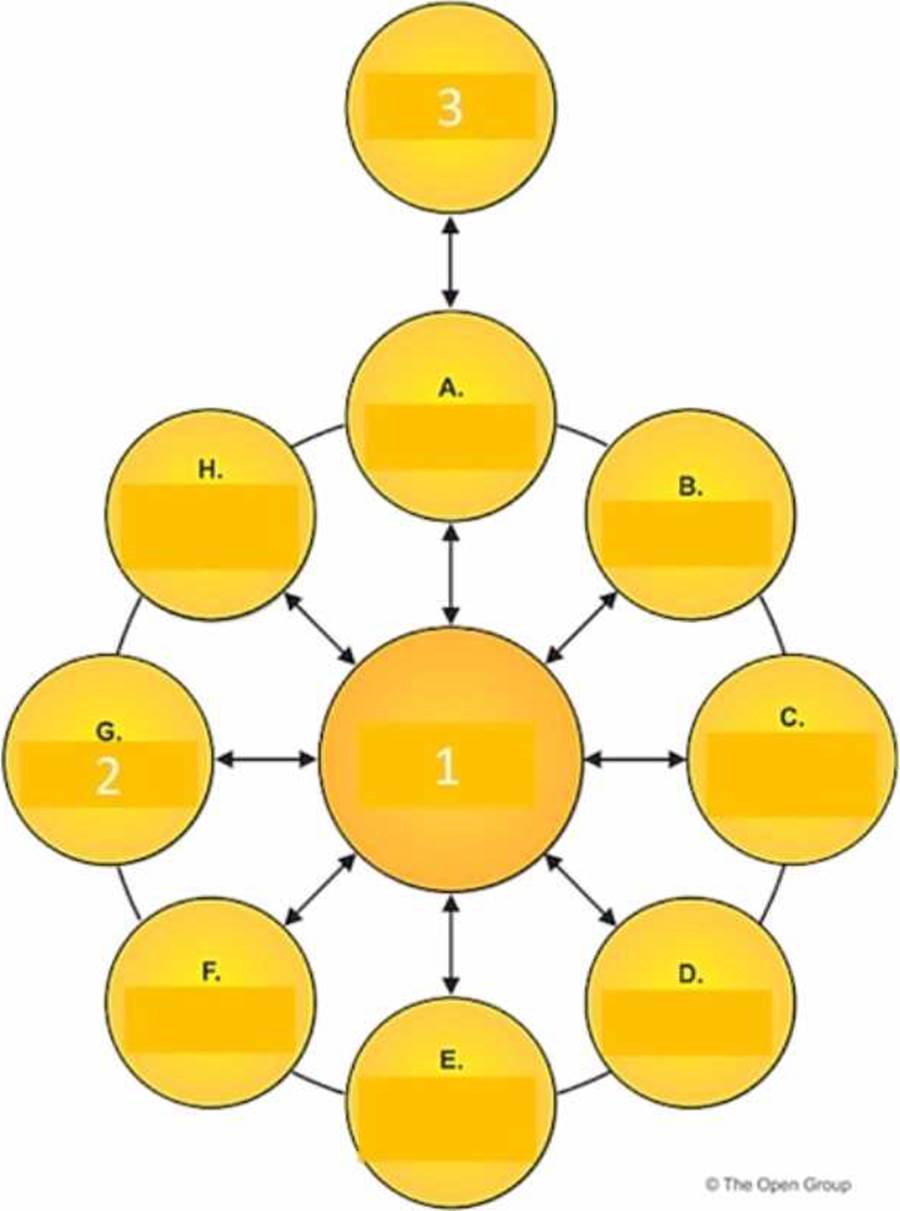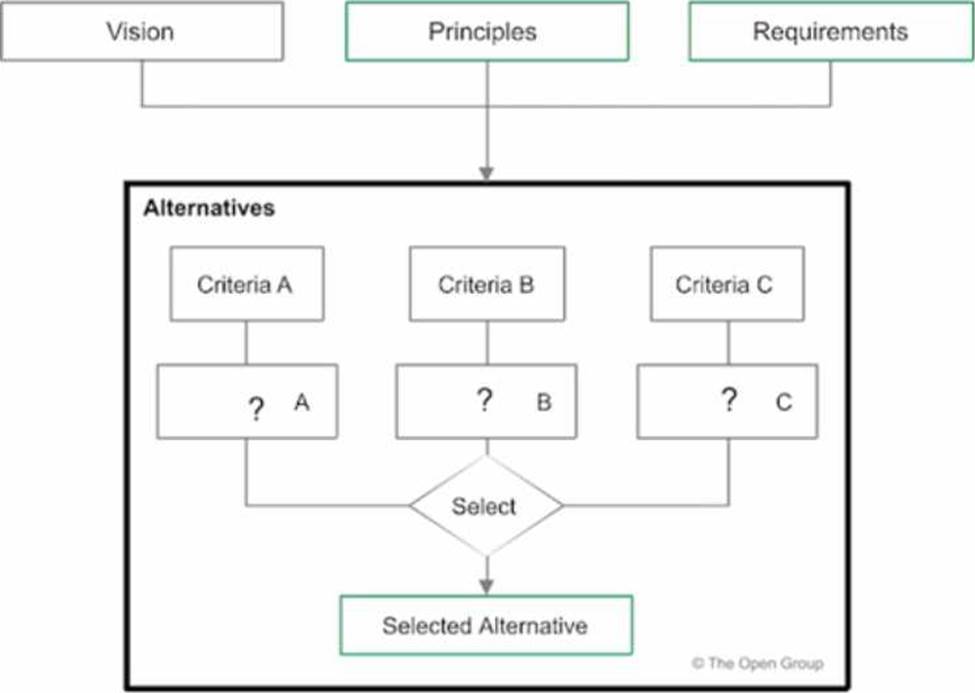Practice Free OGBA-101 Exam Online Questions
Complete the sentence. A key principle of value streams is that value is always defined from the perspective of the_____________
- A . Shareholder
- B . Architect
- C . Sponsor
- D . Stakeholder
D
Explanation:
A key principle of value streams is that value is always defined from the perspective of the stakeholder2. A stakeholder is any person or group who has an interest in or influence on an enterprise or its activities5. A stakeholder can be internal or external to the enterprise. A stakeholder can also be a customer, end user, partner, supplier, regulator, employee, or any other role that interacts with or benefits from the enterprise’s products or services5. Value streams should reflect how stakeholders perceive and measure value in terms of outcomes, benefits, costs, risks, and satisfaction2.
When developing a Business Architecture, which of the following best describes the approach to take If no Architecture Descriptions exist?
- A . Review the contents of the Architecture Repository.
- B . Identify the business goals, business objectives, and drivers for the enterprise
- C . Information should be gathered, and Business Architecture models developed.
- D . Validate the business principles and update the Statement of Architecture Work.
C
Explanation:
In the absence of existing Architecture Descriptions, the development of a Business Architecture would begin with the gathering of relevant information about the business. This information can come from strategic documents, business plans, process documents, and stakeholder interviews, among other sources. Once gathered, this information would be used to create Business Architecture models that articulate the business vision, strategy, governance, organization, and key business processes. These models provide a blueprint that captures the essence of the business and guides subsequent architecture work.
Exhibit.

Consider the diagram of an architecture development cycle.
Select the correct phase names corresponding to the labels 1, 2 and 3?
- A . 1 Architecture Governance – 2 Implementation Governance – 3 Preliminary
- B . 1 Requirements Management – 2 Change Management – 3 Strategy
- C . 1 Requirements Management – 2 Implementation Governance – 3 Preliminary
- D . 1 Continuous Improvement – 2 Migration Planning – 3 Architecture Vision
C
Explanation:
The diagram of an architecture development cycle shows three phases of the TOGAF ADM. The correct phase names corresponding to the labels 1, 2 and 3 are Requirements Management, Implementation Governance, and Preliminary respectively3.
These phases are described as follows:
Requirements Management (label 1): This phase provides a process for managing architecture requirements throughout the ADM cycle3. It ensures that requirements are captured, stored, prioritized, and addressed by relevant ADM phases3. It also ensures that requirements are validated and updated as necessary3.
Implementation Governance (label 2): This phase provides a process for ensuring that the implementation projects conform to the defined architecture3. It involves establishing an implementation governance model, defining architecture contracts and compliance reviews, and monitoring and supporting the implementation projects3.
Preliminary (label 3): This phase provides a process for preparing and planning the architecture project3. It involves defining the scope and vision of the project, customizing the ADM process and content framework, defining principles and governance structures, and evaluating the enterprise architecture maturity and readiness3.
In what TOGAF ADM phase is the information map linked to other business blueprints?
- A . Phase B
- B . Phase E
- C . Phase A
- D . Preliminary Phase
B
Explanation:
Phase E Explanation of Correct Answer. In Phase E (Opportunities and Solutions) of the TOGAF Explanation ADM, the information map is linked to other business blueprints such as the Business Capability Map, the Value Stream Map, and the Business Process Model2. This helps to identify and prioritize opportunities for business improvement and transformation2.
In the TOGAF Architecture Development Method (ADM), the information map is linked to other business blueprints during Phase B, Business Architecture. This phase involves the development of a business architecture to support an agreed Architecture Vision. It is during this phase that the information architecture is developed in detail, which involves mapping the information to the business, hence linking the information map to other business blueprints.
Which of the following is a benefit of organization mapping?
- A . An organization map can be reused for training and employee development.
- B . An organization map highlights inefficiencies and reduces operational costs.
- C . An organization map improves the ability to consume, process, and deliver information.
- D . An organization map improves strategic planning.
D
Explanation:
One of the benefits of organization mapping is that it improves strategic planning2. Organization mapping is a technique that can be used to document and visualize the organizational structure and relationships of an enterprise or a part of it2. Organization mapping can help to align the organizational design with the business strategy, goals, and objectives2. Organization mapping can also help to identify the roles, responsibilities, authorities, accountabilities, and dependencies of different organizational entities2. By providing a clear and consistent view of the organizational landscape, organization mapping can enable better informed and more effective decisions for strategic planning.
Which of the following is a difference between an organization map and an organization chart?
- A . An organization map highlights where in the organization that stakeholder concerns are not being addressed by a business architecture.
- B . An organization map can be impacted by a business model change.
- C . An organization map reduces the time, cost, and risk of business operations.
- D . An organization map is limited to formal relationships between business units.
A
Explanation:
An organization map is a technique that can be used to show how a business architecture addresses stakeholder concerns across different parts of an organization3. It can highlight gaps or overlaps in the coverage of stakeholder concerns by a business architecture. An organization chart, on the other hand, is a diagram that shows the formal structure and hierarchy of an organization, such as reporting relationships and roles4. An organization chart does not necessarily show how stakeholder concerns are addressed by a business architecture.
An organization map differs from an organization chart in that it is designed to show more than just the formal hierarchy and relationships between different units within an organization. It provides a view of the enterprise from the perspective of the business architecture, highlighting areas where stakeholder concerns might not be addressed effectively, whereas an organization chart typically shows the formal reporting structures only.
Which ADM Phases match the following purpose descriptions?

- A . 1 Phase D – 2 Phase B – 3 Phase G – 4 Phase A
- B . 1 Phase C – 2 Phase E – 1 Phase H – 4 Phase C
- C . 1 Phase C – 2 Phase F – 3 Phase H – 4 Phase B
- D . 1 Phase C – 2 Phase F – 3 Phase G- 4 Phase D
D
Explanation:
The ADM Phases that match the purpose descriptions provided are: Phase C for the development of Information Systems Architectures to support the agreed Architecture Vision, Phase F for addressing the move from the Baseline to the Target Architectures by finalizing a detailed Implementation and Migration Plan, Phase G for providing architectural oversight of the implementation, and Phase D for describing the development of the Technology Architecture to support the agreed Architecture Vision.
In what TOGAF ADM phase should the architect locate existing architecture descriptions to create an information map?
- A . Phase E
- B . Phase A
- C . Preliminary Phase
- D . Phase B
B
Explanation:
In the TOGAF ADM cycle, Phase A, the Architecture Vision phase, is where the architect would locate existing architecture descriptions to create an information map. This phase involves understanding the strategic context for the architecture work, defining the scope, identifying stakeholders, creating the Architecture Vision, and obtaining approvals to proceed with the work. Part of this involves reviewing existing documentation to understand the current state of the architecture and the information that is already available, which would be useful for creating an information map.
Consider the following graphic illustrating a method supporting the TOGAF ADM.

What does the method help identify?
- A . Solution Building Blocks
- B . Business Scenarios
- C . Alternative Target Architectures
- D . Architecture Solutions
C
Explanation:
The graphic illustrates a method for developing alternative target architectures in Phase E of the TOGAF ADM1. The method involves identifying and evaluating candidate architectures based on criteria such as business value, cost, risk, and feasibility1. The method helps to identify the most suitable architecture solution for the enterprise.
The graphic illustrates a method that supports the TOGAF ADM by identifying and evaluating alternative target architectures. The process begins with a vision, influenced by principles and requirements, leading to the consideration of alternatives. Each alternative is assessed based on different criteria, leading to the selection of the most suitable target architecture. This is consistent with the TOGAF approach of developing a set of potential architectures and then selecting the one that best meets the enterprise’s needs.
Which of the following describes how business models are used within the TOGAF standard?
- A . To identify, classify, and mitigate risks to the business.
- B . To tailor the enterprise architecture for the business.
- C . To document the factors impacting the business migration plan.
- D . To help formulate architecture and business principles.
B
Explanation:
Business models within the TOGAF standard are used to tailor the enterprise architecture to the specific needs and context of the business. They help in understanding how the business operates, its structure, and how it intends to achieve its goals, which is critical for ensuring that the enterprise architecture aligns with and supports the business objectives.
